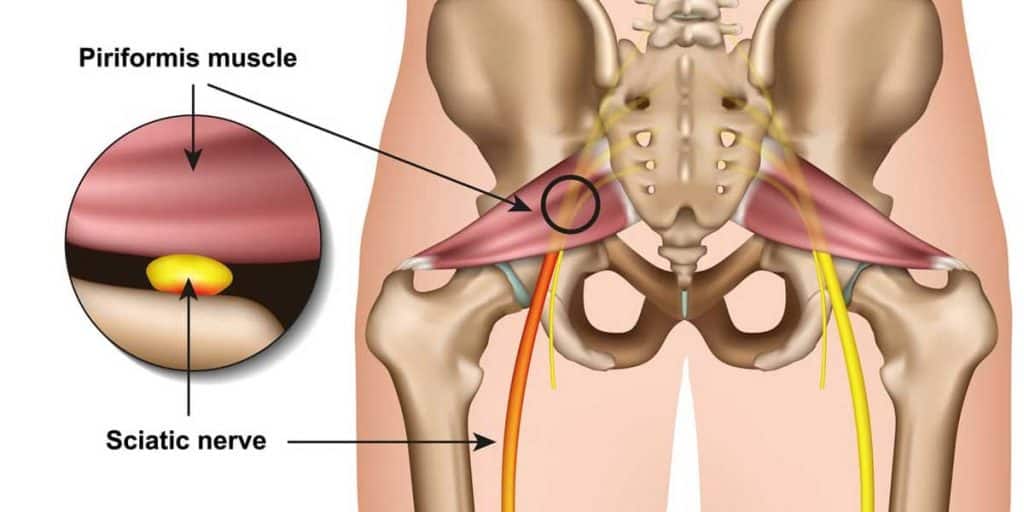How To Sit With Piriformis Syndrome?

If we listen to what the media has to say about sitting, we might never sit again. As per the few self-proclaimed experts around, sitting is the new smoking. While people may have overhyped the disadvantages of sitting, we shouldn’t let our guard down. Irrespective of what others say, sitting is primarily why most people develop pain in their neck, back, and lower back. This pain generally is the result of prolonged hours of sitting on a desk and doesn’t take long to become chronic.
People living a sedentary lifestyle are prone to developing muscular disorders, especially in the neck, back, lower back, and thighs. Therefore, we must be aware of everything that comes with Piriformis Syndrome. In this article, we will be discussing Piriformis Syndrome in detail. Also, we will be laying down the common causes, symptoms, diagnosis, and potential treatment against the same.
What Is Piriformis Syndrome?
The piriformis syndrome refers to the pain in the buttocks caused because of the piriformis muscle that runs across your pelvis to the hip. This is a muscular condition that generally occurs when the sciatic nerve is either compressed or pinched because of over tightness or overuse of the piriformis muscle.
In case of overstretching or an injury, the piriformis muscles tend to tighten, and the tighter it gets, the weaker it becomes. This weaker piriformis muscle can then compress the sciatic nerve, which can cause dull pain in either the lower back, buttocks, thighs, or legs. Pain from piriformis syndrome will be similar to that commonly associated with sciatica, including a sharp shooting pain across the buttocks and down the back of the leg.
1. What Causes The Piriformis Syndrome?
Similar to sciatica, the piriformis syndrome occurs when the sciatic nerve is compressed. However, in the case of the piriformis syndrome, the primary cause of this compression is the over tightness or weakness of the piriformis muscle, which is located deep into the pelvis. When the piriformis muscle compresses/contracts anywhere around the sciatic nerve, it can cause immense irritation, which can send pain shooting down into your hips, thighs, and legs.
Some common risk factors that can trigger piriformis syndrome are as follows.
- Inflammation
- Trauma
- Hematoma
- Scars
- Cysts
- Tumors
- Obesity
- Prolonged Sitting
- Heavy Lifting
The exact reasons why piriformis syndrome occurs are still unclear. However, the risk, as mentioned above, factors are relatively common in triggering this syndrome. Apart from these common causes, some injuries or damage to the muscle can also cause piriformis syndrome. These injuries are
- Sudden Twisting Of The Hip
- Bad Fall
- Vehicular Accident
- Sports Injuries
2. What Are The Symptoms Of The Piriformis Syndrome?
The primary symptom of piriformis syndrome is sciatica, commonly referred to as the pain that originates in the lower back and then makes its way through the buttocks into your legs. Unlike sciatica, the early symptoms of piriformis include a shooting pain in the buttocks and not the lower back. Other early symptoms include
- Pain
- Numbness in the legs
- Tingling feeling in the feet and toes
- Lower back pain
If the situation gets worse, then a patient may start feeling symptoms such as
- Severe pain in the legs, feet, and toes
- Chronic pain in the buttocks
- Muscle spasms
The most common symptoms of piriformis syndrome generally are
- Tenderness of the buttocks
- Numbness or tingling sensation in the buttocks
- Extreme Discomfort in Sitting Down
- Chronic Pain after prolonged hours of sitting down
- Aching pain in the buttocks and legs
Also Read: Bonded Vs. Faux Vs. Genuine Leather
Piriformis Syndrome Vs. Sciatica: What Are The Differences?

The Piriformis Syndrome occurs because of irritation/inflammation caused to your sciatic nerve. However, in piriformis syndrome, the sciatic nerve is compressed/pinched because of the piriformis muscle located deep into your pelvis. The pain caused by piriformis syndrome generally originates from the buttocks and then makes its way through the thighs and into your legs. In piriformis syndrome, the buttocks are the primary area wherein the pain occurs the most.
The Piriformis Syndrome generally occurs when some anatomic changes take place in or near the piriformis muscle. This is why people suffering from piriformis syndrome feel immense pain every time they perform a hip movement.
Sciatica is the irritation/inflammation caused to your sciatic nerve that allows pain to go down into your lower back, buttocks, or leg. This inflammation is primarily caused because of a herniated disk or spinal stenosis. These conditions can compress/pinch one or more sciatic nerves in your lower back which can cause you immense pain and irritation either in your lower back, buttocks, or leg. In sciatica, the leg is the primary area wherein the pain occurs the most and slowly radiates into your feet and toes.
Sciatica generally occurs when some of the other condition causes irritation in or near the sciatic nerve. This is why people feel immense pain every time they lift their legs. In both Sciatica and Piriformis Syndrome, An Ergonomic chair will help you provide some level of comfort to your pain. You may even find chairs that have been specifically been made for people suffering from Sciatica. To make it easier for you, in another website, we have listed some of the best chairs to help you with Sciatica pain.
NOTE: People suffering from Piriformis Syndrome should NEVER perform the stretches prescribed for sciatica. Doing so will only aggravate the condition. Instead, consult your nearest physician, who will prescribe the proper course of action against the same.
How To Sit With Piriformis Syndrome?

Piriformis Syndrome is not a medical condition and generally goes away quickly if adequately taken care of. However, it can be aggravated if not looked at immediately. You must see a doctor at once the moment you start experiencing the symptoms mentioned above. In addition to that, there are a few conventional things you can do to alleviate the pain. These things include making minor tweaks into your lifestyle but are known remedies in tackling the pain.
1. Adjust Your Sitting Posture
An improper posture is a primary reason why the majority of people develop pain in the back and lower back muscles. If you plan on sitting with Piriformis Syndrome, having the right posture in place is key.
Maintaining the right posture ensures that your bones are well aligned with the rest of your body. It also keeps the tension in your muscles and ligaments evenly distributed so that one single muscle of the body does not face too much pressure. Not just with the pain, but a good sitting posture also aids in digestion. Sit up with your back up straight, shoulders back, and buttocks touching the back of your chair. All three curves should be present while sitting. You could also try using a standing desk at work if the pain becomes unbearable.
2. Take Breaks
Breaks are essential in any line of work, especially if you are suffering from any particular muscular disorder. Taking regular breaks at a specific interval is known to improve a person’s efficiency and work productivity. In addition, taking frequent breaks at work is known to keep stress at bay, which can, in turn, improve your performance and overall efficiency. A short break can prevent your muscles from getting tensed up. These breaks help the joints, tissues, and muscles get back in equilibrium and reduces the accumulated stress.
3. Keep Your Back Pockets Empty
Everyone tends to keep their phones, keys, and wallets in their back pockets. This is a habit one acquires over the years. It is okay to keep things in your back pocket when you’re walking or standing. However, you must keep them empty every time you sit. This is because every time you keep something in your right back pocket ( keys/wallets/phone ), it presses directly against your piriformis muscle and the sciatic nerve that runs through it. This can either trigger the piriformis syndrome or can aggravate the condition if you are suffering from it. Therefore, you must keep your back pockets empty whenever you are driving or sitting anywhere.
4. Sit Cross-Legged
Piriformis syndrome is not a medical condition and generally goes away with the right exercises and posture adjustments. However, it can get severe if not treated immediately. Making minor tweaks in your daily routine can help take care of the symptoms. One such thing is sitting cross-legged every time you get a chance. Sitting cross-legged helps stretch the piriformis muscle and glutes and keep the hips open. When you are comfortable in this position, place your hands gently on your knees and press.
Also Read: Best X Rocker Gaming Chairs
Alternative Measures To Alleviate Piriformis Syndrome

It is not possible to teach all the measures mentioned above when being treated against Piriformis syndrome. In such cases, you can opt for alternative measures to alleviate the pain caused by piriformis syndrome. Luckily, there are enough stretches and massage therapies available that can help ease the pain.
Here are some stretches and massages you can opt for alleviating the pain
1. Alternative Ice And Heat Therapy
While fire and ice never go hand-in-hand, heat and ice therapy is one of the primary countermeasures against muscle spasms and joint aches. Ice and heat tend to have a long-lasting effect on the muscles that can gradually rid you of the pain caused by piriformis syndrome. Cold treatment helps dial down the inflammation by reducing the blood flow to the affected area. Meanwhile, heating the affected area helps the muscle relax, in turn untangling the nerves. Alternating between ice and heat therapy is known to reduce exercise-induced muscle pain in the body. Ice is an excellent choice for the first 72 hours after an injury because it helps reduce swelling, which causes pain. Heat, on the other hand, helps soothe stiff joints and relax muscles.
NOTE
- Never Use Extreme Heat.
- Never Apply ICE Directly Onto The Skin
2. Chair Stretches
Prolonged hours of sitting in a chair are one of the primary reasons that cause sciatica and piriformis syndrome. Sitting in a static posture for long hours causes the muscles to tense up, inducing chronic stress in the neck, back, and .lower back. In addition to that, it can put unnecessary pressure on your back muscles and spinal disc. To counter this, chair stretches are an effective solution. Doing the right stretches while being seated can help alleviate the pain. These stretches help relax the muscles and untangling nerves, ultimately preventing stress buildup on your neck, back, lower back, and spinal disks.
To know about the various chair stretches you can perform, watch the following video.
3. Pigeon Stretches
This is a more advanced stretch that directly engages the piriformis muscle. Always consult a doctor before performing a pigeon stretch. The pigeon stretch primarily strengthens the human back and inguinal region. Meanwhile, this stretch relaxes your hips, thighs, and lower back. When performed correctly, the pigeon stretch can increase the flexibility of your hip flexors and lower back muscles. Apart from countering the piriformis syndrome, these pigeon stretches are also effective in countering sciatica.
To perform a pigeon stretch, watch the following video.
The Bottom Line
We hope our article successfully walked you through what exactly Piriformis Syndrome is. While several reasons can cause this condition, prolonged hours of sitting is one of the primary reasons. So, if you wish to keep away from sciatica and piriformis syndrome conditions, you must switch from a sedentary lifestyle towards a more active one. Note that Piriformis syndrome is not a medical condition and generally goes away if taken care of. However, the condition can get worse if overlooked. Therefore, you must see a doctor at once the moment you start experiencing the symptoms mentioned above.






